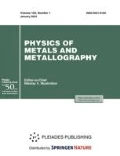Abstract
A mathematical apparatus for studying interdiffusion in three-component systems, using a theoretical approach similar to that previously proposed for describing interdiffusion in binary alloys, has been developed. This approach takes into account the active role of vacancies without assuming their equilibrium distribution; therefore, the equations for component fluxes contain contributions due to the vacancy density gradient. Solutions of a linearized system of interrelated diffusion equations for three components and vacancies are obtained. It has been found that the time dependences of the component density distributions in the diffusion zone, up to terms having a higher order in the expansion in powers of the vacancy concentration, are determined by two coefficients of interdiffusion. These coefficients depend nonlinearly on the component concentrations and the self-diffusion coefficients.
Similar content being viewed by others
REFERENCES
P. G. Shewmon, Diffusion in Solids (McGraw-Hill, Warrendale, 1989).
J. R. Manning, Diffusion Kinetics for Atoms in Crystals (Van Nostrand Reinhold, Princeton, 1968).
I. B. Borovskii, K. P. Gurov, I. D. Marchukova, and Yu. E. Ugaste, Processes of Mutual Diffusion in Alloys (Nauka, Moscow, 1973).
K. P. Gurov, B. A. Kartashkin, and Yu. E. Ugaste, Mutual Diffusion in Multicomponent Metallic Systems (Nauka, Moscow, 1981) [in Russian].
H. Mehrer, Diffusion in Solids – Fundamentals, Methods, Materials, Diffusion-Controlled Processes. Textbook (Springer, Berlin, 2007), Vol. 155, p. 651.
A. Paul, T. Laurila, V. Vuorinen, and S. V. Divinski, Thermodynamics, Diffusion and the Kirkendall Effect in Solids (Springer, Heidelberg, 2014).
A. van de Walle and M. Asta, “High-throughput calculations in the context of alloy design,” MRS Bull. 44, No. 4, 252–256 (2019).
S. V. Divinski, A. Pokoev, N. Eesakkiraja, and A. Paul, “A mystery of ‘sluggish diffusion’ in high-entropy alloys: the truth or a myth?,” Diffus. Found. 17, 69–104 (2018). https://doi.org/10.4028/www.scientific.net/DF.17.69
Y. N. Osetsky, L. K. Beland, A. V. Barashev, and Y. Zhang, “On the existence and origin of sluggish diffusion in chemically disordered concentrated alloys,” Curr. Opin. Solid State Mater. Sci. 22, No. 3, 65–74 (2018).
A. V. Nazarov and K. P. Gurov, “Microscopic theory of mutual diffusion in a binary system with nonequilibrium vacancies,” Fiz. Met. Metalloved. 34, No. 5, 936–941 (1972).
A. V. Nazarov, “Uncompensated vacancy flow and the Kirkendall effect,” Fiz. Met. Metalloved. 35, No. 3, 645–649 (1973).
A. V. Nazarov and K. P. Gurov, “Kinetic theory of mutual diffusion in a binary system. Concentration of vacancies during mutual diffusion,” Fiz. Met. Metalloved. 37, No. 3, 496–503 (1974).
A. V. Nazarov and K. P. Gurov, “Kinetic theory of mutual diffusion in a binary system. Influence of the concentration dependence of self-diffusion coefficients on the process of mutual diffusion,” Fiz. Met. Metalloved. 38, No. 3, 486–492 (1974).
A. V. Nazarov and K. P. Gurov, “Kinetic theory of mutual diffusion in a binary system. Kirkendall effect,” Fiz. Met. Metalloved. 38, No. 4, 689–695 (1974).
A. V. Nazarov and K. P. Gurov, “Accounting for nonequilibrium vacancies in the phenomenological theory of mutual diffusion,” Fiz. Met. Metalloved. 45, No. 4, 885–887 (1978).
K. S. Musin, A. V. Nazarov, and K. P. Gurov, “Effect of ordering on interdiffusion in binary alloys,” Fiz. Met. Metalloved. 63, No. 2, 267–277 (1987).
K. P. Gurov and A. M. Gusak, “Mutual diffusion in an external electric field with allowance for nonequilibrium vacancies,” Fiz. Met. Metalloved. 52, No. 3, 603–611 (1981).
G. S. Zhdanov, K. P. Gurov, and T. V. Kryukova, “Description of the relaxation process for nonequilibrium vacancies created by irradiation,” Vestn. Mosk. Un-Ta, Ser. 3. Fiz. Astron. 27, No. 5, 83–85 (1986).
A. V. Nazarov and A. A. Mikheev, “Effect of elastic stress field on diffusion,” Defect Diffus. Forum 143–147, 177–185 (1997).
V. L. Gapontsev, A. G. Kesarev, and V. V. Kondrat’ev, “Theory of diffusional phase transformations in nanocrystalline alloys upon severe plastic deformation: I. The stage of the formation of concentration inhomogeneities near grain boundaries,” Phys. Met. Metallogr. 94, No. 3, 219–224 (2002).
A. M. Gusak, Yu. A. Lyashenko, S. Kornienko, M. Pasichnyy, A. Shirinyan, and T. V. Zaporozhets, Diffusion-Controlled Solid State Reactions: In Alloys, Thin-Films, and Nanosystems (Wiley, Weinheim, 2010).
A. V. Nazarov, “K.P. Gurov’s hole gas method and an alternative theory of interdiffusion,” Fiz. Khim. Obr. Mater., No. 2, 48–62 (2018).
A. N. Tikhonov and A. A. Samarskii, Equations of Mathematic Physics (Nauka, Moscow, 1972) [in Russian].
G. Korn and T. Korn, Handbook on Mathematics (Nauka, Moscow, 1970).
ACKNOWLEDGMENTS
I am grateful to A.M. Gusak and A.A. Mikheev for numerous discussions of the theory.
Funding
This work was supported by the National Research Nuclear University MEPhI as part of the “Academic Excellence Project " (contract no. 02.a03.21.0005).
Author information
Authors and Affiliations
Corresponding author
Ethics declarations
The author declares that he has no conflicts of interest.
Additional information
Translated by E. Chernokozhin
Rights and permissions
About this article
Cite this article
Nazarov, A.V. On the Theory of Interdiffusion in Ternary Alloys. Phys. Metals Metallogr. 123, 425–431 (2022). https://doi.org/10.1134/S0031918X22050106
Received:
Revised:
Accepted:
Published:
Issue Date:
DOI: https://doi.org/10.1134/S0031918X22050106




